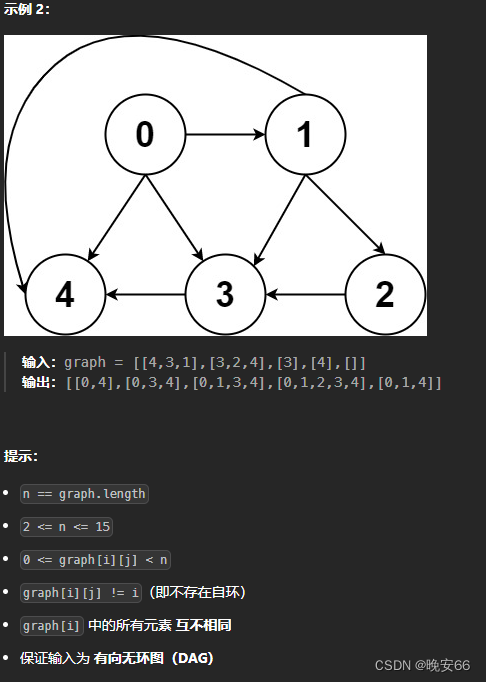文章目录
- 一、题目
- 二、解法
- 三、完整代码
所有的LeetCode题解索引,可以看这篇文章——【算法和数据结构】LeetCode题解。
一、题目


二、解法
思路分析:有向无环图(Directed acyclic graph, DAG)是图论中的一个概念,它指的是一个无回路的有向图。问题是要找到 0 0 0节点到 n − 1 n-1 n−1节点的所有路径,对于所有路径的问题,我们可以用深度优先搜索来做(广度优先搜索也可以)。深度优先搜索DFS一共有三步:
-
- 确定递归参数。一共有两个参数,分别是有向无环图数组和当前节点。
-
- 终止条件。题目要求到 n − 1 n-1 n−1节点,因此 x = = n − 1 x == n - 1 x==n−1时即可终止。
-
- 单层递归逻辑。我们首先定义两个数组result和path,分别用来表示所有可能路径和 0 0 0节点到 n − 1 n-1 n−1节点的路径。for循环遍历当前节点 x x x的连接节点,将其连接节点添加到path中,接着递归,再回溯即可。
程序如下:
class Solution {
private:vector<vector<int>> result; // 所有可能的路径vector<int> path; // 0到n-1的路径void dfs(vector<vector<int>>& graph, int x) { // 1、递归输入参数// 2、终止条件if (x == graph.size() - 1) {result.push_back(path);return;}// 3、单层递归逻辑for (int i = 0; i < graph[x].size(); i++) {path.push_back(graph[x][i]); // 遍历的节点加入到路径中来dfs(graph, graph[x][i]); // 递归path.pop_back(); // 回溯操作,撤销加入到path中的节点}}
public:vector<vector<int>> allPathsSourceTarget(vector<vector<int>>& graph) {path.push_back(0); // 从0节点开始出发dfs(graph, 0); // 深度优先遍历return result;}
};
复杂度分析:
- 时间复杂度: O ( n × 2 n ) O(n \times 2 ^ n) O(n×2n),其中 n n n为节点数量。最坏的情况是每一个节点都可以去往编号比它大的节点,每个节点有经过或者不经过两种情况,共n个节点,此时路径数为 O ( 2 n ) O(2^n) O(2n),每条路径长度为 O ( n ) O(n) O(n)。因此总的时间复杂度为 O ( n × 2 n ) O(n \times 2 ^ n) O(n×2n)。
- 空间复杂度: O ( n ) O(n) O(n),主要为栈的开销。
三、完整代码
# include <iostream>
# include <vector>
using namespace std;class Solution {
private:vector<vector<int>> result; // 所有可能的路径vector<int> path; // 0到n-1的路径void dfs(vector<vector<int>>& graph, int x) { // 1、递归输入参数// 2、终止条件if (x == graph.size() - 1) {result.push_back(path);return;}// 3、单层递归逻辑for (int i = 0; i < graph[x].size(); i++) {path.push_back(graph[x][i]); // 遍历的节点加入到路径中来dfs(graph, graph[x][i]); // 递归path.pop_back(); // 回溯操作,撤销加入到path中的节点}}
public:vector<vector<int>> allPathsSourceTarget(vector<vector<int>>& graph) {path.push_back(0); // 从0节点开始出发dfs(graph, 0); // 深度优先遍历return result;}
};int main() {Solution s1;vector<vector<int>> graph = { {1,2},{3},{3},{} };vector<vector<int>> result = s1.allPathsSourceTarget(graph);for (vector<vector<int>>::iterator it = result.begin(); it != result.end(); it++) {for (vector<int>::iterator jt = (*it).begin(); jt != (*it).end(); jt++) {cout << *jt << " ";}cout << endl;}system("pause");return 0;
}
end



![已解决[notice] A new release of pip available: 22.2 -> 22.2.2异常的正确解决方法,亲测有效!!!](http://pic.xiahunao.cn/已解决[notice] A new release of pip available: 22.2 -> 22.2.2异常的正确解决方法,亲测有效!!!)


—— 剖析神经网络:学习核心的Keras API)











)
